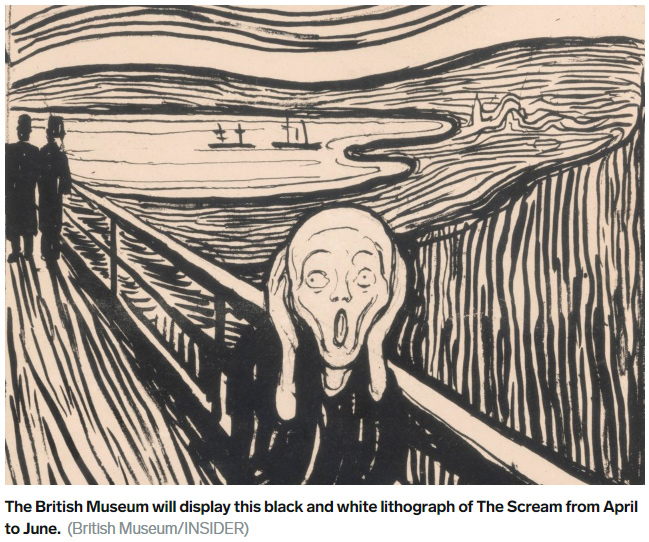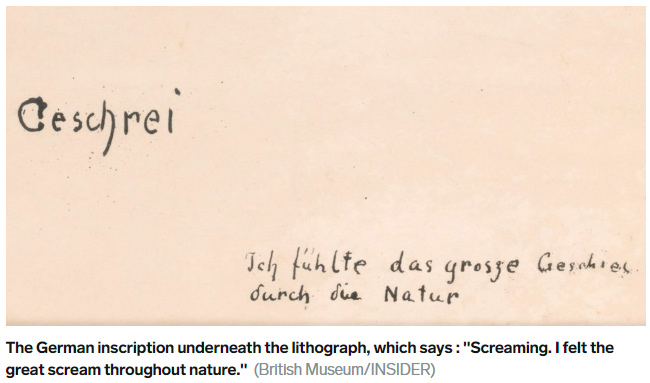名画《呐喊》中的人原来不是在呐喊!大英博物馆揭秘画家本意 The figure in Edvard Munch's iconic 'The Scream' is not actually screaming
中国日报网 2019-03-25 09:05

也许你不认识画家蒙克,但你绝对不会不认识他的名画《呐喊》。很多人都以为《呐喊》中捂着耳朵的人是在尖叫,但他们都会错了画家的本意。

The figure in Edvard Munch's iconic artwork, "The Scream," is not actually screaming, as is widely assumed, the British Museum said on Wednesday. Instead, it is reacting to a scream.
大英博物馆20日称,爱德华·蒙克的经典画作《呐喊》中的那个人其实不是像人们普遍以为的在呐喊或尖叫,而是在对尖叫作出反应。
Munch made clear what was going on in an inscription on a rarely-seen black-and-white version of the image, which Munch annotated with the words "I felt the great scream throughout nature."
蒙克在一幅罕见的黑白版《呐喊》上题词道:“我感觉到大自然中处处都能听到大声尖叫”。这句话清楚表达了他的意图。

According to Giulia Bartrum, who is curating a Munch exhibition at the British Museum which features the black-and-white lithograph, this shows that the figure is hearing the scream rather than making it.
据大英博物馆蒙克画展的策展人朱莉亚·巴图鲁姆介绍,蒙克画展中即将展出的这个黑白版画表明,画中人是听到了尖叫,而不是在尖叫。
Munch, a Norwegian artist, finished the first painting in 1893, but made several more versions.
挪威艺术家蒙克于1893年完成了第一幅《呐喊》画作,但之后又创作了其他几个版本。
In the decades since, the image has morphed into a universal symbol for anxiety, and is clearly reference in the "person screaming" emoji. According to the emojitracker website, it is the 53rd most frequently used emoji.
几十年来,这幅画已经演变成了焦虑的普遍象征,并因此衍生出了表情符号“尖叫者”。根据“表情符号追踪者”网站,“尖叫者”在最常使用的表情符号中排行第53位。

The British Museum is displaying the lithograph as part of its exhibition "Edvard Munch: love and angst" from April 11 to July 21.
大英博物馆将于4月11日至7月21日期间在“爱德华·蒙克:爱和焦虑”展览中展出这幅版画。
lithograph['lɪθəɡræf]: n. 平版印刷品
angst[æŋst]: n. 焦虑;担心
Bartrum told INSIDER: "This rare version of The Scream that we're displaying at the British Museum makes clear that Munch's most famous artwork depicts a person hearing a 'scream' and not, as many people continue to assume and debate, a person screaming."
巴图鲁姆告诉内幕网说:“我们将在大英博物馆展出的这个罕见的《呐喊》版本表明,蒙克最著名的这幅画作中描绘的是一个听到尖叫声的人,而不是像很多人假定和争论的那样是一个尖叫的人。”
"Munch very deliberately included the caption [. . .] on this version to describe how his inspiration came from the anxiety he suddenly felt as he walked along a path in Oslo, a place you can still visit today," Bartrum continued.
巴图鲁姆说:“蒙克在这个版本上特意加了说明,描述他的灵感是怎么来的:他在奥斯陆的一条小路上走着,突然感到一阵焦虑,于是就产生了这幅画的灵感。这条小路你现在还能看到。”

Munch said that the piece recreated the feeling of panic he felt when the sky turned blood red on his walk, according to Bartrum.
据巴图鲁姆介绍,蒙克说,这幅画再现了他在路上看到天空变成血红色时所感到的恐慌情绪。
"I have no doubt that this iconic figure is reacting to nature's external forces on that hillside. What can still be debated is whether, for Munch, those forces were real or psychological," the curator said.
这位策展人说:“毫无疑问,画中人是在对山那头的自然外力作出反应。但是对于蒙克来说,这种力量是真实的还是心理上的,还有待讨论。”
She added that Munch was known for creating images that symbolize strong emotions, like love or jealousy. "The Scream" transmits the feeling of a panic-inducing scream with a simple design: Wavy bands in the sky give the sensation of a quivering tuning fork, as a figure covers its ears, Bartrum said.
她补充说,蒙克以创造象征强烈情感(比如爱或嫉妒)的画作而闻名。《呐喊》通过简单的构图传达出引发恐慌的尖叫感觉;在画中人捂住耳朵时,天空中的带状波浪宛如抖动的音叉,让人感受到声音的震撼。
"This stylized gesture will always be instantly recognizable to people as despair," she said.
她说:“这种程式化的姿势会让人一眼就解读出绝望。”
英文来源:Insider
翻译&编辑:丹妮

















 英语点津微信
英语点津微信 双语小程序
双语小程序